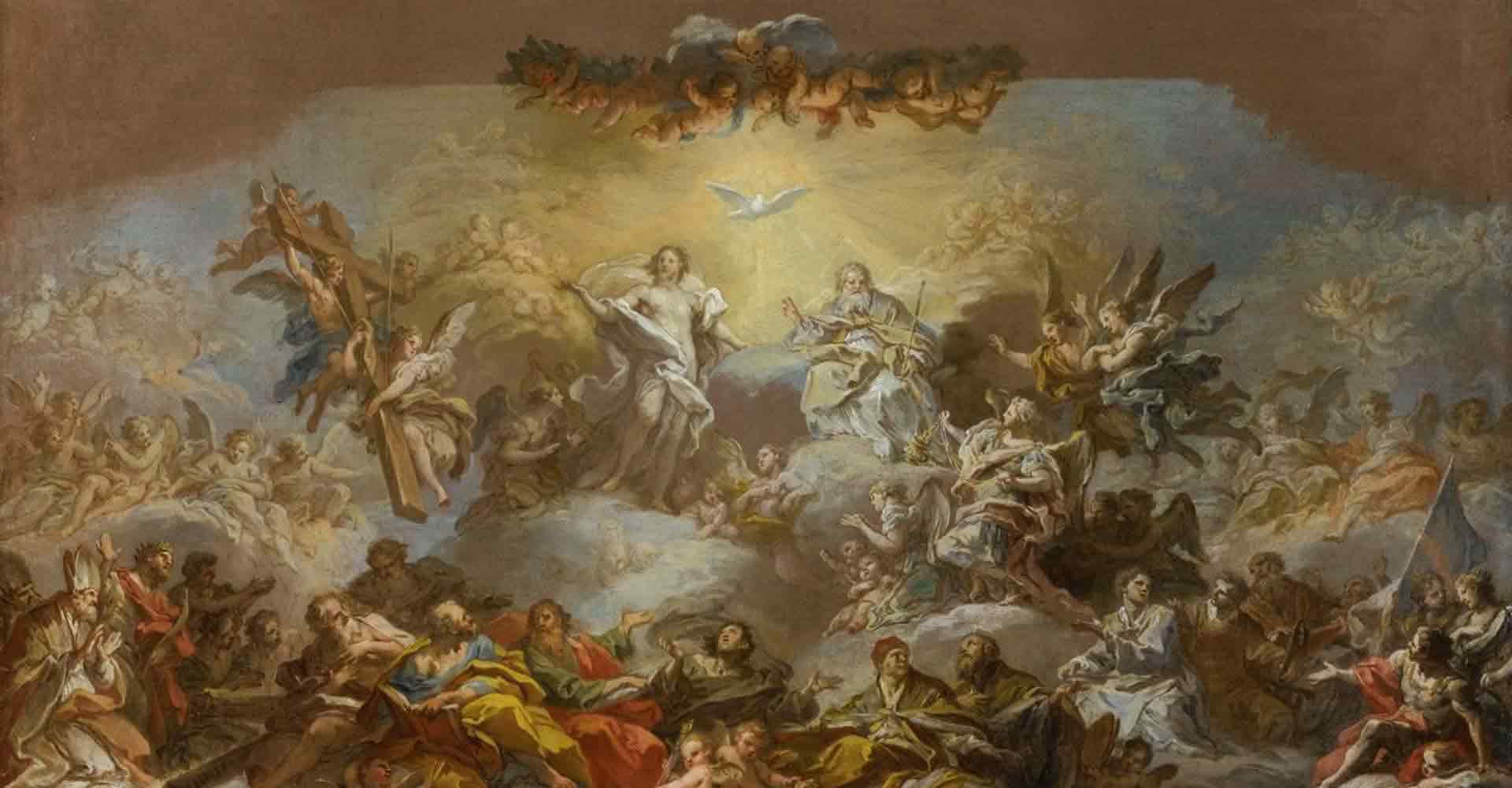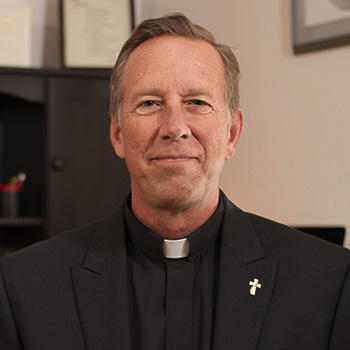 Jesus Christ revealed to humankind what man could never know by the power of the human intellect alone: the mysterious and wondrous secret of the inner life of God: the Most Holy Trinity.
Jesus Christ revealed to humankind what man could never know by the power of the human intellect alone: the mysterious and wondrous secret of the inner life of God: the Most Holy Trinity.
By F. K. Bartels
30 June 2010
Through the revelation of the Holy Trinity a new dimension of understanding is presented to man, which throws a divine and revealing light upon the reality of who the human person is, the purpose of his existence, and the life to which he is called.
“The mystery of the Most Holy Trinity is the central mystery of Christian faith and life. It is the mystery of God in himself. It is therefore the source of all the other mysteries of faith, the light that enlightens them. It is the most fundamental and essential teaching in the hierarchy of the truths of faith” (CCC No. 234).
Over the past twenty-centuries, under the guidance of the Holy Spirit, the Catholic Church has carefully reflected on the mystery of the Most Holy Trinity. From this, our understanding of the relationship between the Holy Trinity and the human person has greatly expanded. This relationship, a bond of life-giving love, is of such depth and magnitude as to be indescribable. It is our Triune God whose life-giving power and love sustains us from moment to moment. It is the Holy Trinity who allows us each breath, provides us with the energy of life, and graces us with that seed of faith deep within our hearts. Yet Christ’s revelation of the inner life of God illumines not only our dependence on God, but who we are as persons, how we should relate to others, and how society should function and exist in relation to God. Therefore the Most Holy Trinity is the Light that enlightens every aspect of the human person.
The Compendium of The Social Doctrine of The Church states: “The revelation in Christ of the mystery of God as Trinitarian love is at the same time the revelation of the vocation of the human person to love. This revelation sheds light on every aspect of the personal dignity and freedom of men and women, and on the depths of their social nature” (CSDC, No. 34).
Errors of Our Age
Pope John Paul II stated in his apostolic letter Mulieris Dignitatem that “Man – whether man or woman – is the only being among the creatures of the visible world that God the Creator has willed for its own sake; that creature is thus a person. Being a person means striving towards self-realization, which can only be achieved through a sincere gift of self. The model for this interpretation of the person is God himself as Trinity, as a communion of Persons.”
Since the model for interpreting ourselves “is God as Trinity, as a communion of Persons,” we can easily extend this principle to include marriage and family. Thus we can understand why the errors of our age concerning the meaning and purpose of marriage are so completely at odds with what the reality of a true and correct interpretation is. For instance, since self-realization “can only be achieved through a sincere gift of self,” what occurs through an insincere gift of self, such as in unmarried couples living together?
Secularist “wisdom” posits that it is “prudent” to first “try out” one’s intended spouse before committing to marriage, thus it is assumed that couples should live together for a time. There is a long list of faulty “reasons” proponents of such a situation cite, which range from “checking compatibility” to “insuring there won’t be any surprises” when and if a couple should decide to get married in the future. Yet in such an incomplete relationship there is no true and sincere gift of self; on the contrary, it is a forgery of a true gift, and often a selfish position in which one person uses another for his or her own advantage. Unmarried couples who live together yet engage in relations reserved only for marriage are not modeling their relationship on the inseparable unity of the Most Holy Trinity. Therefore such circumstances are set against the ultimate reality which Christ so lovingly revealed about his inner life, which is a complete and total gift of self.
John Paul II’s apostolic exhortation Familiaris Consortio reminds the faithful that “marriage and family constitute one of the most precious of human values.” For this reason, the errors of moral relativism so prevalent in our age which labor against the family structure pose a serious threat to society. With penetrating urgency John Paul II reminds the faithful of the many grave attacks which are occurring against the family and life itself:
“Signs are not lacking of a disturbing degradation of some fundamental values: a mistaken theoretical and practical concept of the independence of the spouses in relation to each other; serious misconceptions regarding the relationship of authority between parents and children; the concrete difficulties that the family itself experiences in the transmission of values; the growing number of divorces; the scourge of abortion; the ever more frequent recourse to sterilization; the appearance of a truly contraceptive mentality.”
The Most Holy Trinity: Model of Marital and Familial Love And Unity
When couples begin to look upon themselves and their relationship in Trinitarian light, upon their bond of love which is sealed in the sacrament of matrimony, the depth and meaning of the lifetime commitment they have made to one another takes on a profound significance. This is so because marriage is to be modeled after the three divine Persons of the Trinity whose gift of themselves is one of totality, unity, and fidelity. Thus marriage should reflect these same traits:
“The characteristic traits of marriage are: totality, by which the spouses give themselves to each other mutually in every aspect of their person, physical and spiritual; unity which makes them “one flesh” (Gen 2:24); indissolubility and fidelity which the definitive mutual giving of self requires; the fruitfulness to which this naturally opens itself” (CSDC, No. 217).
As we reflect on the Holy Trinity one of the first things we notice is the inseparable relationship between the three distinct Persons who are the one God. The Father loves the Son, the Son loves the Father, and the Holy Spirit proceeds from the Father and Son. We might say that the life of the Triune God is the highest and supreme principle of familial relationship. This profound bond of unity among the three divine Persons makes them “inseparable in what they are,” and “inseparable in what they do” (CCC No. 267). This inseparable unity also occurs in matrimony: that Christian marital bond between man and wife which is established and sealed by God himself (see CCC Nos. 1639-1640).
The Most Holy Trinity: Origin of Family Life
Let us too reflect on the life-giving aspect of the Holy Trinity. In the Nicene Creed Catholics affirm that the Holy Spirit “proceeds from the Father and the Son.” The Holy Spirit is often understood as the Spirit of Love who proceeds from the infinite ocean of love between Father and Son. We might therefore say that the Holy Spirit proceeds not only from the love of Father and Son but as a result of that love as well. The infinite love of Father and Son is of such an intensity that the Third Person of the Holy Trinity flows forth, if you will.
This aspect of Love giving life to yet more Love is clearly what occurs in marriage when children are conceived. The man and wife, in an act of complete self-giving, produce, as a result of their own love for one another, a new life: a child whose eyes reflect the Most Holy Trinity, and whose love for the parents is so completely bound up in his or her life as to be inseparable from it. At birth, this child will look into his father’s and mother’s eyes; yet he is not meeting his parents for the first time; for he has already known and loved them. The family existed at the moment of the child’s conception, bound together in unity and love.
The importance of the family cannot be overstressed. The Church considers the family as “the first natural society,” and “places it at the center of social life” (CSDC No. 211). John Paul II observed in Christifideles Laici that the family is presented, in the Creator’s plan, as “the primary place of ‘humanization’ for the person and society” and the “cradle of life and love.”
In his address to the Fourth World Meeting of Families in January, 2003, the Venerable John Paul II spoke these wondrous words of encouragement: “Dear Christian families, proclaim joyfully to the whole world the wonderful treasure which you, as domestic churches, possess! Christian couples, in your communion of life and love, in your mutual self-giving and in your generous openness to children, become, in Christ, the light of the world. The Lord asks you daily to be like a lamp which does not remain hidden, but is put “on a stand, and … gives light to all in the house” (Mt 5:15).
Christ’s peace.
*****
Please consider helping to maintain this site. Even small tips help!
Photo: By Sebastiano Conca (Sotheby’s) [Public domain], via Wikimedia Commons

Deacon Frederick Bartels is a member of the Catholic clergy who serves the Church in the diocese of Pueblo. He holds an MA in Theology and Educational Ministry, is a member of the theology faculty at Catholic International University, and is a Catholic educator, public speaker, and evangelist who strives to infuse culture with the saving principles of the gospel. For more, visit YouTube, iTunes and Twitter.
Despite Church teaching, I disagree that human families – husband/wife/child(ren) – are a reflection of the Holy Trinity. For that to be true, it first requires a basic binitarian framework, which then creates a 2-parents/1-child paradigm. But since the Three Persons are coeternal and there is nothing “sexual” or carnal about God’s unity within himself, it’s a poor corollary. A child is the product of the marital union of spouses, not a participant. And since there are no marriages in heaven, these relational roles are not eternally sealed and dissolve upon death. If sex, which is necessary for procreation, is truly the most God-like of acts, why is this contradicted by the Church’s reverence for virginity, chastity, and celibacy as the highest virtues on one’s spiritual path? I think deep down the Church knows that marriage is not the basis of true unconditional love. In fact, it is THE most conditional of all human institutions. Marriage vows (promises) exist for a reason – because the human heart is fickle, attraction between couples wanes, and sexual infidelity is ruinous. We would not need to formally profess such promises out loud….unless we were at risk of BREAKING them. Mother Mary, though wedded, was a virgin. It just doesn’t add up. In other words, the Holy Trinity remains a mystery and our theology surrounding matrimony further obfuscates it……
Jonathan,
Thanks for the comment. I think you might be taking the concept of the family as a reflection of the Holy Trinity too literally. For example, the family’s imperfect unity is a reflection of the perfect unity of the Trinity. But that doesn’t mean a family must consist of only a unity of three persons because the Trinity is comprised of three persons. Analogies all have their weaknesses. They don’t translate perfectly. Nevertheless, they can be helpful for seeing comparisons, connections, and likenesses.